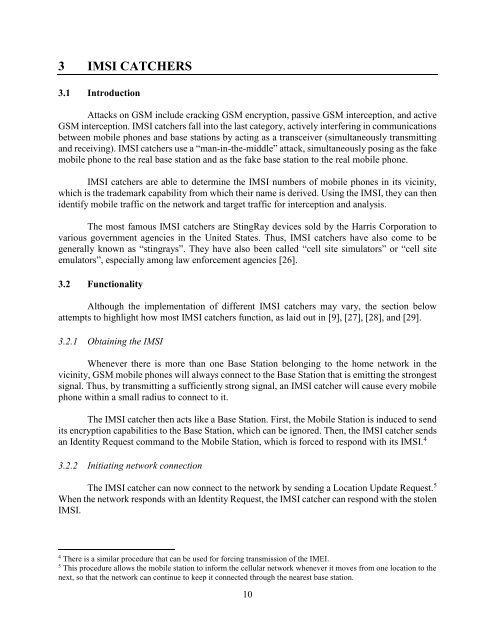IMSI Catchers and Mobile Security
EAS499Honors-IMSICatchersandMobileSecurity-V18F-1
EAS499Honors-IMSICatchersandMobileSecurity-V18F-1
You also want an ePaper? Increase the reach of your titles
YUMPU automatically turns print PDFs into web optimized ePapers that Google loves.
3 <strong>IMSI</strong> CATCHERS<br />
3.1 Introduction<br />
Attacks on GSM include cracking GSM encryption, passive GSM interception, <strong>and</strong> active<br />
GSM interception. <strong>IMSI</strong> catchers fall into the last category, actively interfering in communications<br />
between mobile phones <strong>and</strong> base stations by acting as a transceiver (simultaneously transmitting<br />
<strong>and</strong> receiving). <strong>IMSI</strong> catchers use a “man-in-the-middle” attack, simultaneously posing as the fake<br />
mobile phone to the real base station <strong>and</strong> as the fake base station to the real mobile phone.<br />
<strong>IMSI</strong> catchers are able to determine the <strong>IMSI</strong> numbers of mobile phones in its vicinity,<br />
which is the trademark capability from which their name is derived. Using the <strong>IMSI</strong>, they can then<br />
identify mobile traffic on the network <strong>and</strong> target traffic for interception <strong>and</strong> analysis.<br />
The most famous <strong>IMSI</strong> catchers are StingRay devices sold by the Harris Corporation to<br />
various government agencies in the United States. Thus, <strong>IMSI</strong> catchers have also come to be<br />
generally known as “stingrays”. They have also been called “cell site simulators” or “cell site<br />
emulators”, especially among law enforcement agencies [26].<br />
3.2 Functionality<br />
Although the implementation of different <strong>IMSI</strong> catchers may vary, the section below<br />
attempts to highlight how most <strong>IMSI</strong> catchers function, as laid out in [9], [27], [28], <strong>and</strong> [29].<br />
3.2.1 Obtaining the <strong>IMSI</strong><br />
Whenever there is more than one Base Station belonging to the home network in the<br />
vicinity, GSM mobile phones will always connect to the Base Station that is emitting the strongest<br />
signal. Thus, by transmitting a sufficiently strong signal, an <strong>IMSI</strong> catcher will cause every mobile<br />
phone within a small radius to connect to it.<br />
The <strong>IMSI</strong> catcher then acts like a Base Station. First, the <strong>Mobile</strong> Station is induced to send<br />
its encryption capabilities to the Base Station, which can be ignored. Then, the <strong>IMSI</strong> catcher sends<br />
an Identity Request comm<strong>and</strong> to the <strong>Mobile</strong> Station, which is forced to respond with its <strong>IMSI</strong>. 4<br />
3.2.2 Initiating network connection<br />
The <strong>IMSI</strong> catcher can now connect to the network by sending a Location Update Request. 5<br />
When the network responds with an Identity Request, the <strong>IMSI</strong> catcher can respond with the stolen<br />
<strong>IMSI</strong>.<br />
4<br />
There is a similar procedure that can be used for forcing transmission of the IMEI.<br />
5<br />
This procedure allows the mobile station to inform the cellular network whenever it moves from one location to the<br />
next, so that the network can continue to keep it connected through the nearest base station.<br />
10



